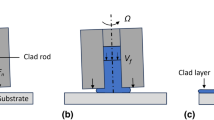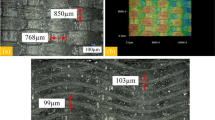Abstract
Brazed superabrasive tool has been widely used in machining of difficult-to-cut materials to improve the machining efficiency and quality. However, the severe wear and associated short service life have to be faced for conventional induction brazed (CIB) abrasive tools during machining processes, owing to its weak bonding strength between abrasive grains and metal-bonded phases. In this case, the method of ultrasonic vibration–assisted induction brazing (UVAIB) was proposed to fabricate tools, through introducing ultrasonic vibration into brazing process to improve the abrasive bonding strength. Here, a novel UVAIB device was developed, and the geometric designation parameters were optimized using a finite element simulating method. In addition, the performance of UVAIB device was tested in terms of the impedance and amplitude. Subsequently, the comparative experiment trials were performed with the brazed abrasive tools under the CIB and UVAIB method. Results show that the ultrasonic energy loss of UVAIB device can be reduced, and then, the amplification value and vibration uniformity reach 8 and 92%, respectively. In addition, a large number of pores and macro-cracks inside tool’s metallic matrix for CIB can be observed, whereas the number of pores is reduced by 75%, and only fewer and smaller micro-cracks are found for UVAIB. Furthermore, compared with the grains’ intergranular fracture for CIB, UVAIB exhibits the transgranular fracture mode due to its higher bonding strength after adopting the ultrasonic vibrating method.
















Similar content being viewed by others
Availability of data and material
All data generated or analyzed during this study are included in the present article.
References
Xiao HZ, Wang SY, Xiao B (2022) Microstructural characteristics and mechanical properties of diamond grinding wheel brazed with modified Ni-Cr-W alloy using continuous tunnel furnace. Ceram Int 48:9258–9268
Mukhopadhyay P, Ghosh A (2022) The making and performance of patterned-monolayer brazed diamond wheel produced with Ag-based novel active filler. J Manuf Process 73:220–234
Zhang L (2021) Filler metals, brazing processing and reliability for diamond tools brazing: a review. J Manuf Process 66:651–668
Li QL, Ding K, Lei WN, Chen JJ, He QS, Chen ZZ (2021) Investigation on induction brazing of profiled cBN wheel for grinding of Ti-6Al-4V. Chin J Aeronaut 34:132–139
Zhao B, Ding WF, Xiao GD, Zhao JS, Li Z (2022) Self-sharpening property of porous metal-bonded aggregated cBN wheels during the grinding of Ti–6Al–4V alloys. Ceram Int 48:1715–1722
Wu SX, Zhang FL, Ni YQ, Chen F, Yan ZQ (2020) Grinding of alumina ceramic with microtextured brazed diamond end grinding wheels. Ceram Int 46:19767–19784
Wu QP, Ouyang ZY, Wang Y, Yang H, Song K (2019) Precision grinding of engineering ceramic based on the electrolytic dressing of a multi-layer brazed diamond wheel. Diam Relat Mater 100:107552
Ghosh A, Chattopadhyay AK (2007) On grain-failure of an indigenously developed single layer brazed CBN wheel. Ind Diamond Rev 1:59–64
Ding WF, Xu JH, Chen ZZ, Miao Q, Yang CY (2013) Interface characteristics and fracture behavior of brazed polycrystalline CBN grains using Cu–Sn–Ti alloy. Mater Sci Eng A 559:629–634
Mukhopadhyay P, Simhan DR, Ghosh A (2017) Challenges in brazing large synthetic diamond grit by Ni-based filler alloy. J Mater Process Technol 250:390–400
Wu KL, Yuan XJ, Li T, Wang HD, Xu C, Luo J (2019) Effect of ultrasonic vibration on TIG welding–brazing joining of aluminum alloy to steel. J Mater Process Technol 266:230–238
Nie Y, Zhu L, Lang Q, Wang Q, Yu P, Hu XQ (2022) Ultra-rapid and low-temperature soldering of hypereutectic Al-Si alloys by ultrasonic-assisted soldering with In interlayer in air for electronic application. J Adv Joini Process 5:100115
Cui W, Li SQ, Yan JC, He JS, Liu Y (2015) Ultrasonic-assisted brazing of sapphire with high strength Al-4.5Cu-1.5Mg alloy. Ceram Int 41:8014–8022
Zhang CG, Ji HJ, Xu HB, Liang M, Huang JY, Pei S, Li MY (2020) Interfacial microstructure and mechanical properties of ultrasonic-assisted brazing joints between Ti–6Al–4V and ZrO2. Ceram Int 46:7733–7740
Chen XG, Yan JC, Ren SC, Wang Q, Wei JH, Fan GH (2014) Microstructure, mechanical properties, and bonding mechanism of ultrasonic-assisted brazed joints of SiC ceramics with ZnAlMg filler metals in air. Ceram Int 40:683–689
Huang GQ, Huang JR, Zhang MQ, Mu DK, Zhou GT, Xu XP (2018) Fundamental aspects of ultrasonic assisted induction brazing of diamond onto 1045 steel. J Mater Process Technol 260:123–136
Li HB, Chen T, Duan ZY, Zhang YW, Li HT (2022) A grinding force model in two-dimensional ultrasonic-assisted grinding of silicon carbide. J Mater Process Technol 304:117568
Chen Y, Hu ZW, Yu YQ, Lai ZY, Zhu JG, Xu XP, Peng Q (2022) Processing and machining mechanism of ultrasonic vibration-assisted grinding on sapphire. Mater Sci Semicond Process 142:106470
Wen J, Tang JY, Zhou WH (2022) Study on formation mechanism and regularity of residual stress in ultrasonic vibration grinding of high strength alloy steel. J Manuf Process 66:608–622
Bie WB, Zhao B, Zhao CY, Yin L, Guo XC (2021) System design and experimental research on the tangential ultrasonic vibration-assisted grinding gear. Int J Adv Manuf Technol 116:597–610
Zhang P, Zhang XC, Cao X, Yu X, Wang YQ (2021) Analysis on the tool wear behavior of 7050–T7451 aluminum alloy under ultrasonic elliptical vibration cutting. Wear 466:203538
Airao J, Nirala CK (2022) Machinability of Ti-6Al-4V and Nimonic-90 in ultrasonic-assisted turning under sustainable cutting fluid. Materials Today: Proceedings 62:7396–7400
Peng ZL, Zhang XY, Zhang DY (2021) Effect of radial high-speed ultrasonic vibration cutting on machining performance during finish turning of hardened steel. Ultrasonics 111:106340
Yang HL, Wang JJ, Zhang JF, Feng PF, Wu ZJ, Yu DW (2021) On the material removal mechanism in rotary ultrasonic milling of ultralow-density silica aerogel composites. J Manuf Process 70:621–635
Chen GJ, Xu JK, Wang JD, Li Y, Wang JQ, Yu ZJ, Yu HD (2022) Numerical and experimental study on the amplitude effect of ultrasonic vibration-assisted milling of 3D needle-punched Cf/SiC composite. Ceram Int 48:17893–17914
Wu BF, Cao Y, Zhao JS, Ding WF (2021) The effect of superimposed ultrasonic vibration on tensile behavior of 6061–T6 aluminum alloy. Int J Adv Manuf Technol 116:1843–1854
Yang CQ, Shan XB, Xie T (2016) Titanium wire drawing with longitudinal-torsional composite ultrasonic vibration. Int J Adv Manuf Technol 83:645–655
Cao Y, Zhu YJ, Li HN, Wang CX, Su HH, Yin Z, Ding WF (2020) Development and performance of a novel ultrasonic vibration plate sonotrode for grinding. J Manuf Process 57:174–186
Zhao B, Chang BQ, Wang XB, Bie WB (2019) System design and experimental research on ultrasonic assisted elliptical vibration grinding of Nano-ZrO2 ceramics. Ceram Int 45:24865–24877
Bai W, Wang K, Du DX, Zhang JG, Huang W, Xu JF (2022) Design of an ultrasonic elliptical vibration device with two stationary points for ultra-precision cutting. Ultrasonics 120:106662
Du PF, Han L, Qiu X, Chen WS, Deng J, Liu YX, Zhang JJ (2022) Development of a high-precision piezoelectric ultrasonic milling tool using longitudinal-bending hybrid transducer. Int J Mech Sci 222:107239
Lu LL, Zhang SM, Xu J, He HJ, Zhao XM (2017) Numerical study of titanium melting by high frequency inductive heating. Int J Heat Mass Transf 108:2021–2028
Kranjc M, Zupanic A, Miklavcic D, Jarm T (2010) Numerical analysis and thermographic investigation of induction heating. Int J Heat Mass Transf 53:3585–3591
Lin SY, Guo H, Xu J (2018) Actively adjustable step-type ultrasonic horns in longitudinal vibration. J Sound Vib 419:367–379
Yang JJ, Fang ZD, Wei BY, Deng XZ (2009) Theoretical explanation of the ‘local resonance’ in stepped acoustic horn based on four-end network method. J Mater Process Technol 209:3106–3110
Funding
This work was financially supported by the National Natural Science Foundation of China (Nos. 51921003, 92160301, 52175415, and 52205475), Natural Science Foundation of Jiangsu Province (No. BK20210295), Superior Postdoctoral Project of Jiangsu Province (No. 2022ZB215), the Open Foundation State Key Laboratory of Mechanical Transmissions (No. SKLMT-MSKFKT-202101), the Postgraduate Research & Practice Innovation Program of Jiangsu Province (No. SJCX21-0106), and the Special Projects for the Reengineering of Industrial Foundation and the High-quality Development of Manufacturing Industry (No. TC210H02X).
Author information
Authors and Affiliations
Contributions
Kaida Cai: experimentation, data curation, and writing the original draft. Biao Zhao: data collection and manuscript revision. Bangfu Wu: experimentation and methodology. Wenfeng Ding: supervision, conceptualization, and methodology.
Corresponding author
Ethics declarations
Ethics approval and consent to participate
The article follows the guidelines of the Committee on Publication Ethics (COPE) and involves no studies on human or animal subjects.
Consent for publication
Not applicable.
Competing interests
The authors declare no competing interests.
Additional information
Publisher's Note
Springer Nature remains neutral with regard to jurisdictional claims in published maps and institutional affiliations.
Rights and permissions
Springer Nature or its licensor holds exclusive rights to this article under a publishing agreement with the author(s) or other rightsholder(s); author self-archiving of the accepted manuscript version of this article is solely governed by the terms of such publishing agreement and applicable law.
About this article
Cite this article
Cai, K., Zhao, B., Wu, B. et al. Structure design and experimental study on ultrasonic vibration–assisted induction brazing cubic boron nitride abrasive tools. Int J Adv Manuf Technol 123, 943–955 (2022). https://doi.org/10.1007/s00170-022-10231-1
Received:
Accepted:
Published:
Issue Date:
DOI: https://doi.org/10.1007/s00170-022-10231-1




